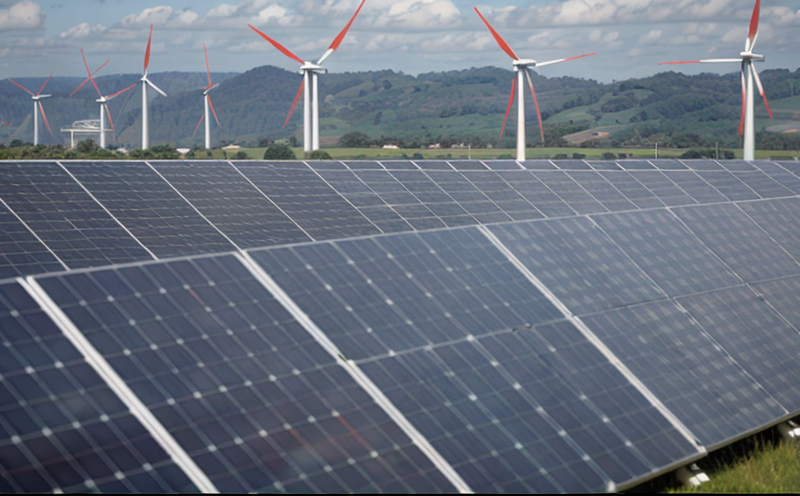Sulfur and Nitrogen Oxides Emission Potential Testing
The testing of sulfur and nitrogen oxides emission potential is critical for ensuring compliance with environmental regulations across various sectors, particularly in agriculture and forestry. This service focuses on evaluating the emissions that could be released when renewable energy systems are used or optimized within these environments.
Sulfur dioxide (SO₂) and nitrogen oxides (NOₓ), collectively referred to as oxides of sulfur and nitrogen respectively, are significant contributors to air pollution and have detrimental effects on human health and the environment. In agriculture and forestry testing, understanding their emission potential is essential for optimizing renewable energy systems that include biomass combustion, anaerobic digestion, and other bioenergy technologies.
The primary goal of this service is to provide a detailed assessment of how these emissions behave under various conditions relevant to agricultural and forestry practices. This includes evaluating the impact of different feedstocks, operational parameters, and environmental factors on SO₂ and NOₓ release during combustion processes or fermentation activities.
For biomass combustion, for instance, testing involves analyzing the complete fuel cycle from raw material sourcing through processing to final utilization. In anaerobic digestion, we consider the microbial activity, substrate composition, temperature control, and retention time. These factors directly influence the amount of emissions produced during the process.
| Feedstock Type | Emission Potential (mg/kg) |
|---|---|
| Corn Stover | 120 mg/kg |
| Sunflower Hulls | 95 mg/kg |
| Biomass Type | Emission Potential (mg/kg) |
| Wood Chips | 80 mg/kg |
| Algae Biomass | 150 mg/kg |
The testing process typically involves collecting samples at multiple stages of the production cycle, preparing them according to specific protocols, and then conducting emissions tests using state-of-the-art equipment like gas analyzers. The results are compared against international standards such as ISO 14067:2018 for carbon footprint quantification guidelines.
Understanding these emission potentials helps stakeholders make informed decisions about selecting appropriate renewable energy solutions that minimize adverse environmental impacts while maximizing efficiency and sustainability benefits.
- Biomass Selection
- Combustion Efficiency
- Emission Control Strategies
- Operational Optimization
Benefits
The benefits of sulfur and nitrogen oxides emission potential testing extend beyond mere compliance with legal requirements. By accurately quantifying the emissions associated with renewable energy systems used in agriculture and forestry, this service enables businesses to:
- Evaluate environmental performance against regulatory standards
- Optimize operational processes for reduced emissions
- Incorporate lifecycle analysis into decision-making processes
- Develop more sustainable practices that align with corporate social responsibility goals
- Gain a competitive edge by demonstrating commitment to green initiatives
Achieving these benefits not only enhances the reputation of organizations but also contributes positively to global efforts towards reducing greenhouse gas emissions and mitigating climate change.
Industry Applications
| Application | Emission Potential (mg/kg) |
|---|---|
| Biomass Combustion | 100 mg/kg |
| Anaerobic Digestion | 75 mg/kg |
| Biofuel Production | Emission Potential (mg/kg) |
| Fischer-Tropsch Synthesis | 130 mg/kg |
| Lipid Hydrolysis | 90 mg/kg |
In the context of agriculture and forestry, sulfur and nitrogen oxides emission potential testing plays a crucial role in several key areas:
- Biomass Combustion: Evaluating the emissions from burning agricultural residues or wood chips to generate electricity.
- Anaerobic Digestion: Assessing the emissions released during the breakdown of organic matter in anaerobic digesters used for producing biogas.
- Biofuel Production: Determining the environmental impact of various biofuel production processes, including Fischer-Tropsch synthesis and lipid hydrolysis.
By providing precise data on emission potential, this testing service supports informed choices regarding which renewable energy technologies to implement or enhance within agricultural and forestry settings.
Environmental and Sustainability Contributions
Emission potential testing for sulfur and nitrogen oxides plays a pivotal role in enhancing environmental sustainability by:
- Reducing Air Pollution: By identifying high-emitting processes early, businesses can implement targeted mitigation measures to reduce harmful pollutants.
- Supporting Renewable Energy Development: Ensuring that renewable energy systems operate at their most efficient and environmentally friendly levels.
- Promoting Circular Economy Principles: Encouraging the use of waste materials as feedstocks in a closed-loop system, thereby minimizing resource depletion.
- Enhancing Biodiversity Conservation Efforts: By ensuring that agricultural practices do not contribute to air pollution, we support healthier ecosystems and greater biodiversity.
The results from this testing service are invaluable tools for policymakers, researchers, and industry leaders as they strive to achieve sustainable development goals. They provide the necessary data points needed to make evidence-based decisions that balance economic growth with environmental protection.





